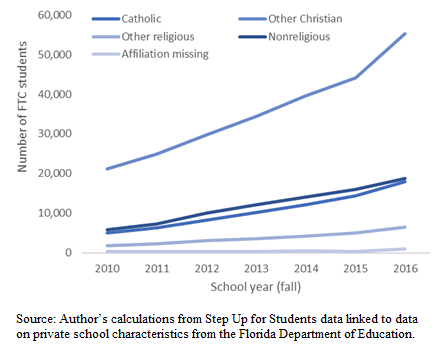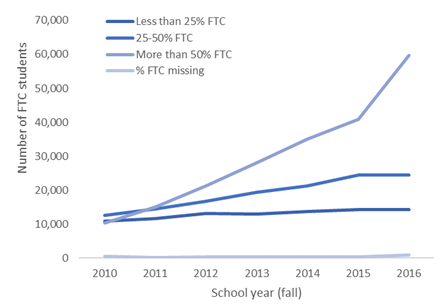Update (Dec. 5): This article has been significantly revised to reflect an update of the underlying report published by the Brookings Institution. The author of that report previously miscalculated the growth of schools where a majority of students use tax credit scholarships. This post, and the second chart, have been updated to reflect those corrections.
New data from the Urban Institute look at the question: Is the nation’s largest private school choice program fueling the growth of academically dubious schools?
The think tank earlier this fall released a report showing low-income students who use Florida tax credit scholarships are more likely to enroll in college and obtain associate degrees. Some types of private schools had stronger positive effects. Those included Catholic schools, non-Christian religious schools and schools where fewer than half of students used scholarships.
The program has doubled in size since 2012, growing from just over 50,000 students to more than 100,000. In a follow-up report released this morning, Urban Institute researchers asked whether that meant more students use scholarships to enroll in the types of schools with weaker results.
The answer, according to an article published by the Brookings Institution: Not when it comes to religious affiliations. But the proportion of schools where a majority of students use scholarships has grown.Non-religious schools had some of the weakest results in Urban’s study, with basically no positive effect. But their share of students hasn’t increased much in recent years.

Schools where a majority of students relied on scholarships also did not perform well, according to the Urban Institute’s analysis. The proportion of these schools appears to be rising.

The researchers conclude:
This analysis indicates that participation in the FTC program has shifted toward schools with weaker track records of improving student outcomes, according to one broad categorization (share of students on scholarships) but not another (religiosity and denomination of school). This suggests that the average effect of FTC participation may decline, if the pattern of college enrollment effects from prior years persists.
This report provides less guidance on the broader issue of the ideal level of government regulation in private school choice programs. There is significant disagreement about how to balance the goal of keeping (or weeding) out low-performing schools with the possibility that regulations will discourage high-performing schools from participating.
Of course, it’s possible that as the program grows, the types of schools that increase students’ chances of getting to college might change, also. It’s worth noting that as the program has grown, its results measured by student test scores have remained strikingly stable. On average, students continue to make about a year’s worth of progress in a year’s time.
Step Up For Students, which publishes this blog, helps administer the tax credit scholarship program.


